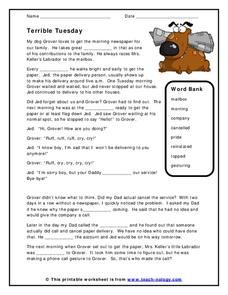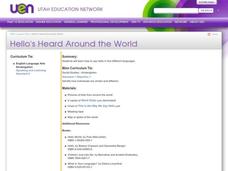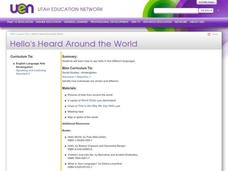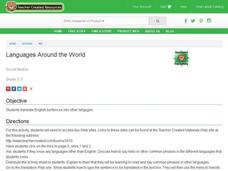Houghton Mifflin Harcourt
Look at Us!: English Language Development Lessons (Theme 1)
Start off your young English language learners with this packet of materials, which covers three weeks of instructions. After completing the unit, kids will have practiced the letters K through Z, read several story books, talked with...
Hello-Hello
Spanish – Learn Spanish (Hello-Hello)
Pick up basic conversational Spanish with animated videos featuring three characters: Pablo, Ana, and Marcos. As Pablo and Marcos get to know Ana, they talk about a variety of subjects. Learners can acquire the vocabulary in each...
Reed Novel Studies
Hello Universe: Novel Study
Every neighborhood has its own unique cast of characters, and the crew in the novel Hello Universe is no exception. The characters in Erin Entrada Kelly's novel take center stage in a study guide based on the text. Readers answer...
Curated OER
Say Hello! Around the World
Hello! Bonjour! Paivaa! Ni hao! Teach learners of all ages how to say hello in several different languages. There are project ideas for younger learners and older learners. Kids love learning a different language, even if it's just this...
Curated OER
Foods and Languages of the World
Students explore cultures around the world. In this cross-curriculum geography lesson, students listen to This is the Way We Go to School , a Book about Children around the World , and locate various countries on the globe and a map....
Goodwill Community Foundation, Inc.
Saying Hello: Common Greetings in Spanish
The first thing Spanish learners need to know is how to say hello! An interactive resource guides beginners into basic Spanish greetings with audio prompts and self-assessment checklists.
Teach-nology
Terrible Tuesday
Who could have canceled Grover's newspaper? Complete a cloze activity in which kids read a short passage about a dog who loves to retrieve the paper, and fill in the blanks using a word bank.
Hello-Hello
Portuguese – Learn Portuguese
Marcos and Paulo have just met Ana. Watch as they use Portuguese to introduce themselves and get to know each other. Language learners then complete a series of activities designed to help them master each brief conversation.
English Grammar
Gerund or Infinitive – Fill in the Correct Form
Middle schoolers love listening to music, and they also love to listen to music. So what's the difference? Spell out the nuanced ways to use gerunds and infinitives with a 50-question grammar exercise. Given short sentences and verbs,...
Curated OER
Goodbye snail mail, hello email
Sixth graders send a picture as an attachment in an email and define email vocabulary. In this email lesson plan, 6th graders learn how to properly send an email and the etiquette that goes along with it.
Pala Software
SpellBoard
How do you spell great? G-R-E-A-T! Ensure that your pupils can spell great and so much more with this effective app.
Royal Shakespeare Company
RSC Activity Toolkit: Othello
Jealousy, betrayal, revenge! Hello, content! The Royal Shakespeare Company's Othello toolkit is a must-have for any in-depth study of one of Shakespeare's most famous tragedies. The 25-page packet is divided into 20 sections, each...
Curated OER
"Hello's" Heard Around the World
Pupils say hello in five different languages (Spanish, Swahili, French, Portuguese, and Japanese). They are introduced to the countries of these languages (Mexico, Tanzania Africa, France, Brazil, and Japan).
Curated OER
"Hello's" Heard Around the World
Students demonstrate how to say hello in five different languages. They discover the many differences in the way students speak across the world.
Curated OER
Languages Around the World
Students discover languages of the world. In this global languages lesson, students use the Internet to discover and translate common phrases in various languages.
Curated OER
Newspaper Writing in Various Genres
In this newspaper writing in various genres worksheet, students create 8 newspaper articles in different genres (list provided), following the examples given, with grading rubric included.
Pearson
Used To
Your class used to be confused about verb tenses, but now they understand more about the past tense! Practice the different ways to use used to in writing with a clear slideshow presentation, which includes negative and positive...
Curated OER
Foods and Languages of the World
Students study world cultures with an emphasis on languages and cultures. In this world cultures activity, students study the countries of Spain, China, Italy, and the United States. Students read the story Everybody Cooks Rice and move...
Curated OER
Hello, How Do You Do?
Students role play proper greetings and etiquette in formal and informal work and social situations. Students compare and contrast introductions and conversational conventions in their native country and in the United States by writing...
Curated OER
"Hello" Game
Students listen as the teacher sings the first phrase of the "Hello" song (included with the lesson). They respond by singing the second phrase. They learn to pronounce the hello equivalent in other languages. The teacher sings the first...
Curated OER
The Hello Goodbye Window: Visual Art
Young scholars create a portrait of themselves with a grandparent. In this visual art activity, students read the book entitled The Hello Goodbye Window and discuss the events. Young scholars then draw a portrait of themselves and...
National First Ladies' Library
"Just a Little Bit Different": Inclusive Classrooms, Inclusive Schools
Learners explore visible and invisible differences, those of language, religion, dress, ethnicity, gender, etc. with their classmates. They play Bingo with a created list of classroom differences. Afterward, they write a short paper...
Curated OER
Hello My Name is . . . Helvetica
Students play various games to help create a classroom community. In this name recognition lesson, students combine their name recognition skills with newly learned art and geometric vocabulary. First students discover vocabulary that...
Curated OER
Identifying and Generating Rhyming Words, Body
Can you tell which words rhyme? Choose a body part as a starting word (i.e. head) and begin saying words to see if learners can identify those that rhyme. Does red rhyme with head? Continue giving examples, some rhyming and others not....

























